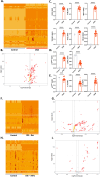PseudoCell: A Multivalued Logical Regulatory Network to Investigate Premature Senescence Dynamics and Heterogeneity
- PMID: 40353054
- PMCID: PMC12064993
- DOI: 10.1002/agm2.70020
PseudoCell: A Multivalued Logical Regulatory Network to Investigate Premature Senescence Dynamics and Heterogeneity
Abstract
Purpose: Premature cellular senescence is a pivotal process in aging and age-related diseases, triggered by various stressors. However, this is not a homogeneous phenotype, but a heterogeneous cellular state composed of multiple senescence programs with different compositions. Therefore, understanding the complex dynamics of senescence programs requires a systemic approach. We introduce PseudoCell, a multivalued logical regulatory network designed to explore the molecular intricacies of premature senescence.
Methods: PseudoCell integrates key senescence signaling pathways and molecular mechanisms, offering a versatile platform for investigating diverse premature senescence programs initiated by different stimuli.
Results: Validation through simulation of classical senescence programs, including oxidative stress-induced senescence and oncogene-induced senescence, demonstrates its ability to replicate molecular signatures consistent with empirical data. Additionally, we explore the role of CCL11, a novel senescence-associated molecule, through simulations that reveal potential pathways and mechanisms underlying CCL11-mediated senescence induction.
Conclusions: In conclusion, PseudoCell provides a systematic approach to dissecting premature senescence programs and uncovering novel regulatory mechanisms.
Keywords: aging; bioinformatics; cellular senescence; in silico modeling; premature senescence.
© 2025 The Author(s). Aging Medicine published by Beijing Hospital and John Wiley & Sons Australia, Ltd.
Conflict of interest statement
The authors declare no conflicts of interest.
Figures






Similar articles
-
Eotaxin-1/CCL11 promotes cellular senescence in human-derived fibroblasts through pro-oxidant and pro-inflammatory pathways.Front Immunol. 2023 Oct 4;14:1243537. doi: 10.3389/fimmu.2023.1243537. eCollection 2023. Front Immunol. 2023. PMID: 37860000 Free PMC article.
-
Insulin-like growth factor-1 attenuates oxidative stress-induced hepatocyte premature senescence in liver fibrogenesis via regulating nuclear p53-progerin interaction.Cell Death Dis. 2019 Jun 6;10(6):451. doi: 10.1038/s41419-019-1670-6. Cell Death Dis. 2019. PMID: 31171766 Free PMC article.
-
Oxidative stress and senescence in aging kidneys: the protective role of SIRT1.EXCLI J. 2024 Aug 27;23:1030-1067. doi: 10.17179/excli2024-7519. eCollection 2024. EXCLI J. 2024. PMID: 39391060 Free PMC article. Review.
-
Aflatoxin B1 exposure triggers inflammation and premature skin aging via ERMCS/Ca2+/ROS signaling cascade.Int Immunopharmacol. 2023 Nov;124(Pt B):110961. doi: 10.1016/j.intimp.2023.110961. Epub 2023 Sep 22. Int Immunopharmacol. 2023. PMID: 37742367
-
Genes and pathways involved in senescence bypass identified by functional genetic screens.Mech Ageing Dev. 2021 Mar;194:111432. doi: 10.1016/j.mad.2021.111432. Epub 2021 Jan 8. Mech Ageing Dev. 2021. PMID: 33422562 Review.
References
LinkOut - more resources
Full Text Sources
